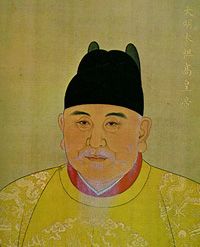We use cookies to make your experience better. To comply with the new e-Privacy directive, we need to ask for your consent to set the cookies. Learn more.
The emergence of diversity
15th to 19th century

The first Ming Emperor People discovered more and more the advantages of loose teas, not only because the preparation was easier. Above all, however, it was noticed that a not insignificant part of the ingredients and flavours were lost during the production of the pressed teas. The official end of pressed tea came in the form of a decree of the first Ming Emperor (Ming Dynasty: 1368 – 1644). He decreed on 16.9.1391 that only loose teas should be delivered to the imperial court. This decree came less from a gourmet than from a pragmatic head of government. The Ming Emperor was faced with a country that was completely run down by the Mongols and completely destroyed by the war that drove the Mongols out of China. To restore social peace, he adopted a series of measures to relieve the peasants. These included a switch from the very costly production of tea cakes to loose tea. In practice, the decree only documented the already irreversible trend among the population.
Another important development in the tea industry has been the rapid increase in diversity. On the one hand, there was a wide variety of green tea varieties.
In a text from 1593, 97 different tea names were listed. Almost every small village in South China produces its own tea, most of them still with a beautiful name.
Similar to wine, the location of the plantations and the vintages are decisive for the taste of the teas.
There was a list of growing regions that were famous for their tea. With the exception of a few changes, the list is still valid today.
Today, as then, the top tea growing regions include the cities of
Hangzhou with the
Lung Ching tea and
Suzhou with the
Pi Lo Chun
(not to be confused with the Formosa Pi Lo Chun from Taiwan).
On the other hand, the diversity was expressed in the different tea varieties.
All tea varieties known today, Pu Erh, black tea, Oolong, yellow tea, white tea and flavoured tea, were created in this period.
In the production of green tea, a distinction is now made between two methods: Steam or roasted tea. In the case of steam tea, after plucking, the leaves were first treated with steam to stop the fermentation process, and then the leaves were dried. With roasted tea, the leaves were first slightly dried and then briefly roasted in a cast-iron pan over a wood fire. The clearly preferred method was the roasting method.

